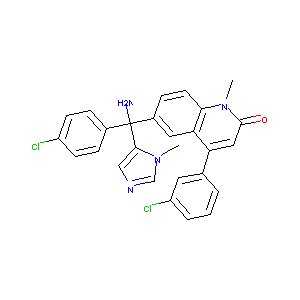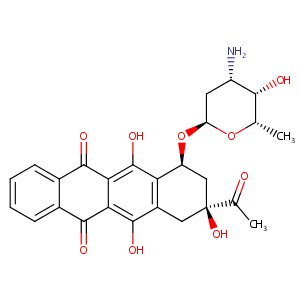| 1 |
Recurrent recessive mutation in deoxyguanosine kinase causes idiopathic noncirrhotic portal hypertension.Hepatology. 2016 Jun;63(6):1977-86. doi: 10.1002/hep.28499. Epub 2016 Mar 31.
|
| 2 |
ClinicalTrials.gov (NCT00093990) Tipifarnib Versus Best Supportive Care in the Treatment of Newly Diagnosed Acute Myeloid Leukemia (AML). U.S. National Institutes of Health.
|
| 3 |
Clinical pipeline report, company report or official report of the Pharmaceutical Research and Manufacturers of America (PhRMA)
|
| 4 |
Emerging therapies for multiple myeloma. Expert Opin Emerg Drugs. 2009 Mar;14(1):99-127.
|
| 5 |
Idarubicin FDA Label
|
| 6 |
URL: http://www.guidetopharmacology.org Nucleic Acids Res. 2015 Oct 12. pii: gkv1037. The IUPHAR/BPS Guide to PHARMACOLOGY in 2016: towards curated quantitative interactions between 1300 protein targets and 6000 ligands. (Ligand id: 7083).
|
| 7 |
Tipifarnib in the treatment of newly diagnosed acute myelogenous leukemia. Biologics. 2008 Sep;2(3):491-500.
|
| 8 |
Farnesyltransferase inhibitor R115777 (Zarnestra, Tipifarnib) synergizes with paclitaxel to induce apoptosis and mitotic arrest and to inhibit tumor growth of multiple myeloma cells. Blood. 2005 Jun 15;105(12):4759-66. doi: 10.1182/blood-2004-11-4307. Epub 2005 Feb 22.
|
| 9 |
Genetic disruption of the PI3K regulatory subunits, p85, p55, and p50, normalizes mutant PTPN11-induced hypersensitivity to GM-CSF. Haematologica. 2012 Jul;97(7):1042-7. doi: 10.3324/haematol.2011.046896. Epub 2012 Feb 7.
|
| 10 |
Ras homologue enriched in brain is a critical target of farnesyltransferase inhibitors in non-small cell lung cancer cells. Cancer Lett. 2010 Nov 1;297(1):117-25. doi: 10.1016/j.canlet.2010.05.004.
|
| 11 |
Pharmacogenetics of tipifarnib (R115777) transport and metabolism in cancer patients. Invest New Drugs. 2004 Aug;22(3):285-9.
|
| 12 |
Quantitative high-throughput profiling of environmental chemicals and drugs that modulate farnesoid X receptor. Sci Rep. 2014 Sep 26;4:6437. doi: 10.1038/srep06437.
|
| 13 |
Drugs@FDA. U.S. Food and Drug Administration. U.S. Department of Health & Human Services.
|
| 14 |
Human intestinal transporter database: QSAR modeling and virtual profiling of drug uptake, efflux and interactions. Pharm Res. 2013 Apr;30(4):996-1007.
|
| 15 |
Amonafide L-malate is not a substrate for multidrug resistance proteins in secondary acute myeloid leukemia. Leukemia. 2008 Nov;22(11):2110-5.
|
| 16 |
In vitro evaluation of cytochrome P450-mediated drug interactions between cytarabine, idarubicin, itraconazole and caspofungin. Hematology. 2004 Jun;9(3):217-21.
|
| 17 |
A Quantitative Approach to Screen for Nephrotoxic Compounds In Vitro. J Am Soc Nephrol. 2016 Apr;27(4):1015-28. doi: 10.1681/ASN.2015010060. Epub 2015 Aug 10.
|
| 18 |
The use of biochemical markers in cardiotoxicity monitoring in patients treated for leukemia. Neoplasma. 2005;52(5):430-4.
|
| 19 |
The induction of apoptosis by daunorubicin and idarubicin in human trisomic and diabetic fibroblasts. Cell Mol Biol Lett. 2008;13(2):182-94. doi: 10.2478/s11658-007-0045-7. Epub 2008 Apr 10.
|
| 20 |
Refining the human iPSC-cardiomyocyte arrhythmic risk assessment model. Toxicol Sci. 2013 Dec;136(2):581-94. doi: 10.1093/toxsci/kft205. Epub 2013 Sep 19.
|
| 21 |
ClinicalTrials.gov (NCT00096122) Idarubicin, Cytarabine, and Tipifarnib in Treating Patients With Newly Diagnosed Myelodysplastic Syndromes or Acute Myeloid Leukemia
|
|
|
|
|
|
|


